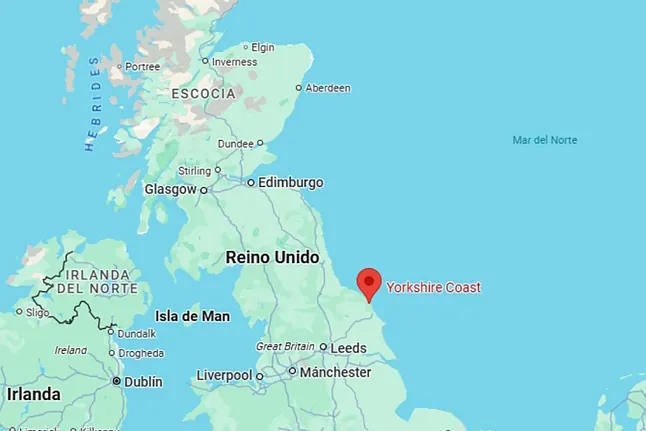Two ships, a tanker and a cargo ship, collided on Monday in the North Sea off the coast of East Yorkshire. Video images broadcasted by the BBC and apparently filmed from a nearby vessel show thick black smoke coming out of both ships.
The UK Maritime and Coastguard Agency stated that several rescue boats and a rescue helicopter were sent to the North Sea location, as well as a plane and nearby fire-fighting vessels.
Martyn Boyers, CEO of the port of Grimsby East, initially stated that 13 of the victims had arrived at that point on a Windcat 33 high-speed vessel and another 19 on a port pilot boat. He added that he had been told that "a huge fireball" was seen.
"It's too far for us to see, about 10 miles away, but we've seen the vessels taking them," Boyers detailed. "They must have sent a distress signal. Fortunately, there was already a crew transfer vessel there. Since then, there has been a fleet of ambulances to pick up anyone they can find," he concluded.
Later, local MP Graham Stuart said he had spoken to the Transport Secretary and only one person had been hospitalized. "The other 36 sailors from both crews are safe and sound", he specified. By late afternoon, the ambulance team leader corrected that information. He confirmed that 36 had been rescued and none of them hospitalized.
According to the Marine Traffic website, the Stena Immaculate is a 183-meter-long tanker and chemical transport ship under the American flag. It had departed from a Greek port in the Aegean Sea and was destined for Hull, the site says. The vessel was built in 2017, according to the Martime Optima website, and weighs around 50,000 tons.
The Swedish company Stena Bulk confirmed to AFP that it owns the tanker, adding that it is under the American flag and operated by the company Crowley, without further comments.
"While anchored off the North Sea coast near Hull, UK, the tanker Stena Immaculate, operated by Crowley, was struck by the container ship Solong," the company said in a statement. "The Stena Immaculate suffered a rupture in a cargo tank containing Jet-A1 fuel, and the crew abandoned the ship after several onboard explosions," it added.
This fuel is used by aviation and was to be delivered to the US Army Military Sealift Command, as confirmed by an official from this country to the Reuters agency. The organization is responsible for providing logistical support to combat units deployed anywhere in the world.
The cargo ship involved in the accident is the Solong, a Portuguese-flagged container ship. It was built in 2005, measures 140.6 meters in length according to Marine Optima, and has the capacity to transport 9,500 tons of cargo. Its destination was Rotterdam, according to the Marine Traffic website.
Among its cargo were, among other products, 15 containers of sodium cyanide, according to a report from the maritime data provider Lloyd's List Intelligence. Additionally, an unspecified amount of alcohol, according to the incident report citing a message from local coastguards.
The UK Health Security Agency has warned that exposure to these sodium cyanide salts can cause headaches, nausea, dizziness, nervousness, confusion, changes in heart rate, drowsiness, and in more severe cases, respiratory problems or even death.
Abdul Khalique, director of the Maritime Center at Liverpool John Moores University, stated that apparently, the cargo ship's crew had not "maintained proper radar watch," as required by international maritime regulations.
The Prime Minister's office has assured that details about the cause of the collision are "still being clarified," and a Prime Minister's spokesperson described the situation as "extremely concerning."
"We appreciate the emergency services for their quick response. I understand that the Ministry of Transport is working closely with the coastguard to assist in the incident response," this spokesperson emphasized.
The Maritime and Coastguard Agency has announced an "assessment" of a "likely" pollution risk. "The incident is ongoing, and an assessment of the likely pollution response required is being carried out," a spokesperson stated.
Greenpeace UK has stated that it is too early to assess the extent of any environmental damage resulting from the collision, which took place in a heavily trafficked fishing ground and near important seabird colonies.
While damages are being assessed, the director of the environmental organization 'Yorkshire Wildlife Trust,' Martin Slater, pointed out that the fuel spill could be "devastating for the wildlife of the Humber estuary" as many birds gather on the coast before the nesting season, and there are "significant numbers" of seals in the area.
"The East Yorkshire coast is home to protected and significant colonies of seabirds such as puffins, guillemots, gannets, and gulls," noted this expert, who believes that if the spill enters the Humber estuary, it could "potentially be devastating for the fish and the tens of thousands of migratory birds in the marshes."
"Although the images seem concerning, from the perspective of the impact on the aquatic environment, they are less worrying than if it were crude oil because most aviation fuel evaporates very quickly," detailed Mark Hartl, from the Marine Biodiversity and Biotechnology Center at Heriot-Watt University in Scotland.
Mark Sephton, professor of organic geochemistry at Imperial College London, agrees that aviation fuel breaks down more rapidly than crude oil, and that warmer temperatures accelerate biodegradation. "In the end, it all depends on the rate of fuel introduction and the rate of destruction by bacteria," he explained. "Let's hope the latter prevails."
